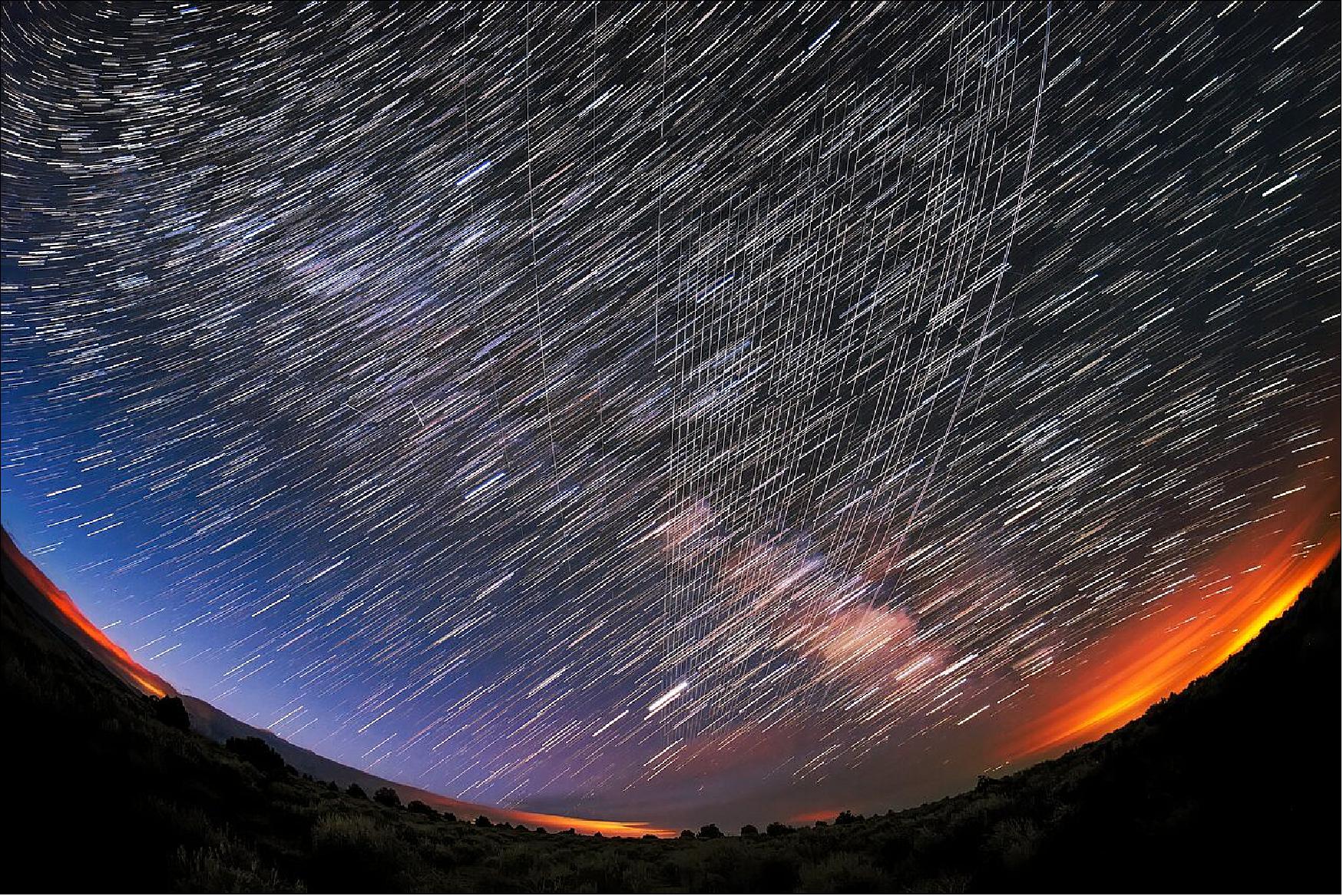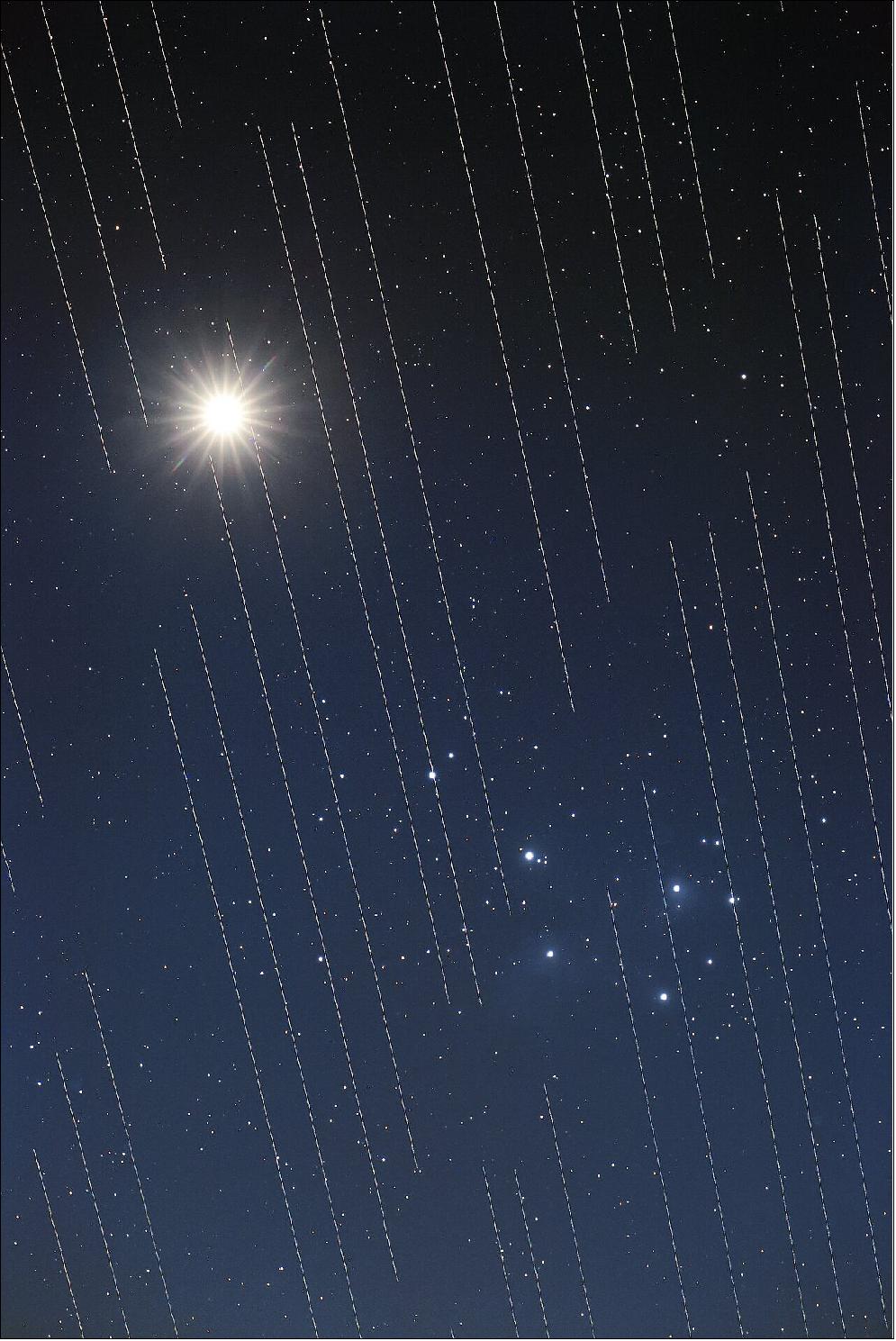Mitigating Effects of Satellites on Astronomy
Astronomy and Telescopes
NOIRLab & SKAO to Coordinate Work to Mitigate the Effects of Satellite Constellations on Astronomy
February 5, 2022: The International Astronomical Union (IAU) is establishing a center to help astronomers deal with the adverse effects of satellite constellations. 1) 2)
The IAU said Feb. 3 it selected a proposal jointly submitted by NOIRLab (National Optical-Infrared Astronomy Research Laboratory), run by the National Science Foundation (NSF), and the SKAO (Square Kilometer Array Observatory ) to operate its Centre for the Protection of the Dark and Quiet Sky from Satellite Constellation Interference. The center will formally start operations April 1.

The center will bring together astronomers and other experts on various efforts to address the visible and radio interference caused by commercial constellations like OneWeb and SpaceX's Starlink. That work will include the development of software tools for astronomers, work on national and international policies, community outreach and work with industry on relevant technologies.
"The center will bring together astronomers, industry, policy experts and the wider community, and act as a bridge between all stakeholders," said Piero Benvenuti, former general secretary of the IAU and director of the new center, in a press briefing. "The center is essentially a coordination center."
The center will not, at least to start, be large. "The initial budget is not a big one," he said. He did not disclose specific funding but noted the center would have a staff of seven full-time equivalents. Both NOIRLab and SKAO will provide some in-kind contributions. He said that, as the center expands its service, particularly with software, it will need more resources. "One of the tasks of the center will be to start fundraising with companies and foundations."
That included, he said, companies developing satellite constellations. Before the IAU established the center, some astronomers had been working with satellite constellation operators, including through a series of workshops and other meetings. At the same time, other astronomers were sharply and publicly critical of those companies for launching thousands of satellites that are increasingly interfering with optical and radio astronomy.
Connie Walker of NOIRLab, a co-director of the center, said the center has established relationships with Amazon, OneWeb and SpaceX. "Each of those three major companies have indicated quite strongly that they would like to work with us wholeheartedly, and do as much as they can," she said.
Most of that focus has been SpaceX, which has now launched more than 2,000 Starlink satellites. As part of those efforts, SpaceX first tested darkening reflective surfaces on the satellite to reduce its brightness, then installed visors to block sunlight from reflecting off those surfaces. That has helped reduce the brightness of newer satellites, although a recent study found those satellites have not yet quite reached the magnitude threshold recommended by astronomers.
Walker noted that OneWeb, whose satellites are in orbits far above the maximum altitude of 600 km recommended by astronomers to minimize the time each night those satellites are visible, told astronomers they're not able to lower their orbits. However, the company said would take other steps, such as coating reflective surfaces, to reduce their brightness.
"It's better to make these agreements than to go through regulations because regulations take a long time to solidify, but we're hopeful in talking with them already that some comprises can be made," she said.
However, the center will also address some policy solutions, including through the United Nations Committee on the Peaceful Uses of Outer Space and the International Telecommunication Union. Those efforts could be part of broader discussions about space sustainability, said Richard Green of the University of Arizona.
"We think this IAU center can significantly contribute to overcoming these challenges" in developing policy, he said. "It ties into the whole suite of concerns about space traffic management."
He also endorsed a cooperative approach with industry in the hopes of creating a "voluntary corporate culture" that seeks to mitigate the impact of those companies' constellations. "On the other hand, the notion of having our policy approach to regulators in multiple countries is to codify these good intentions so that, if the profit motive does start to intrude and make these mitigations difficult for them, we have some backup to say there really is a requirement that they look into these issues."
NSF Press Conference
• February 3, 2022: At a press conference today, NSF's NOIRLab announced that it has been selected, along with the SKA Observatory (SKAO), by the International Astronomical Union to host the new IAU Centre for the Protection of the Dark and Quiet Sky from Satellite Constellation Interference. The center coordinates collaborative multidisciplinary international efforts with institutions and individuals and works across multiple geographic areas to help mitigate the negative impact of satellite constellations on ground-based optical and radio astronomy observations as well as humanity's enjoyment of the night sky. 3)
- NSF's NOIRLab and the intergovernmental organization the SKA Observatory (SKAO), headquartered in the UK, have been named as co-hosts of the newly established Centre for the Protection of the Dark and Quiet Sky from Satellite Constellation Interference.

- "Satellite interference is an increasing problem for ground-based astronomy, and I am pleased NOIRLab will be partnering with our International colleagues at the IAU, and with our radio colleagues at the SKAO to find solutions that meet the needs of the scientific community and the satellite industry," said AURA (Association of Universities for Research in Astronomy) President Matt Mountain. AURA operates NOIRLab under a cooperative agreement with the NSF. "Continuing to preserve a dark and quiet sky is essential for both astronomy and for sustaining the curiosity of future generations, who find inspiration from simply looking up."
- The International Astronomical Union called for the establishment of the center in 2021. The mission of the center is to coordinate efforts and unify voices across the global astronomical community with regard to the protection of the dark and quiet sky from satellite constellation interference. The center aims to bring together astronomers, satellite operators, regulators and the wider community and acts as a bridge between all stakeholders to protect the dark and quiet skies. The center builds on the vast amount of work carried out by the two host institutions and the international astronomical community, recognizing the various interests of different observatories according to wavelength, existing regulations, and expected impact. Some of this work is outlined in recent reports such as the one from the SATCON2 conference, the reports of the online conferences Dark and Quiet Skies for Science and Society I and II (co-organized by UNOOSA, the IAU and Spain, with support from NOIRLab, and a Conference Room Paper presented to the 58th meeting of the Scientific and Technical Sub-Committee (STSC) of the UN Committee on the Peaceful Uses of Outer Space (COPUOS).
- The vision of the center is to become the leading voice for astronomical matters that relate to the protection of the dark and quiet sky from satellite constellations and to act as a hub of information and resources to which any stakeholder group will be able to contribute and from which they can use in support of their own activities.
- The staff members for the center are distributed over two main locations: Tucson, Arizona, USA, and Jodrell Bank, near Manchester, United Kingdom. The director is Piero Benvenuti, former IAU General Secretary, and the co-directors are Connie Walker (NSF's NOIRLab) and Federico Di Vruno (SKAO). A number of organizations [1] have pledged to provide additional support to the center.
- Debra Elmegreen, IAU President, notes "The new center is an important step towards ensuring that technological advances do not inadvertently impede our study and enjoyment of the sky. I am confident that the center co-hosts can facilitate global coordination and bring together the necessary expertise from many sectors for this vital effort."
More Information
- NSF's NOIRLab (National Optical-Infrared Astronomy Research Laboratory), the US center for ground-based optical-infrared astronomy, operates the international Gemini Observatory (a facility of NSF, NRC–Canada, ANID–Chile, MCTIC–Brazil, MINCyT–Argentina, and KASI–Republic of Korea), Kitt Peak National Observatory (KPNO), Cerro Tololo Inter-American Observatory (CTIO), the Community Science and Data Center (CSDC), and Vera C. Rubin Observatory (operated in cooperation with the Department of Energy's SLAC National Accelerator Laboratory). It is managed by the Association of Universities for Research in Astronomy (AURA) under a cooperative agreement with NSF and is headquartered in Tucson, Arizona. The astronomical community is honored to have the opportunity to conduct astronomical research on Iolkam Du'ag (Kitt Peak) in Arizona, on Maunakea in Hawai‘i, and on Cerro Tololo and Cerro Pachón in Chile. We recognize and acknowledge the very significant cultural role and reverence that these sites have to the Tohono O'odham Nation, to the Native Hawaiian community, and to the local communities in Chile, respectively.
- The SKAO, formally known as the SKA Observatory, is an inter-governmental organisation composed of Member States from five continents. Its mission is to build and operate cutting-edge radio telescopes to transform our understanding of the Universe, and deliver benefits to society through global collaboration and innovation. Headquartered in the UK, its two telescope arrays will be constructed in Australia and South Africa and be the two most advanced radio telescope networks on Earth. A later expansion is envisioned in both countries and other African partner countries. Together with other state-of-the-art research facilities, the SKAO's telescopes will explore the unknown frontiers of science and deepen our understanding of key processes, including the formation and evolution of galaxies, fundamental physics in extreme environments and the origins of life. Through the development of innovative technologies and its contribution to addressing societal challenges, the SKAO will play its part to address the United Nations' Sustainable Development Goals and deliver significant benefits across its membership and beyond. The SKAO recognises and acknowledges the Indigenous peoples and cultures that have traditionally lived on the lands on which the SKAO facilities are located.
- The IAU is the international astronomical organisation that brings together more than 12 000 active professional astronomers from more than 100 countries worldwide. Its mission is to promote and safeguard astronomy in all its aspects, including research, communication, education and development, through international cooperation. The IAU also serves as the internationally recognised authority for assigning designations to celestial bodies and the surface features on them. Founded in 1919, the IAU is the world's largest professional body for astronomers.

References
1) Jeff Foust, New center to coordinate work to mitigate effect of satellite constellations on astronomy," SpaceNews, 5 February 2022, URL: https://spacenews.com/
new-center-to-coordinate-work-to-mitigate-effect-of-satellite-constellations-on-astronomy/
2) "New Center for Satellite Constellation Interference," Space Daily, 4 February 2022, URL: https://www.spacedaily.com/reports/
New_Center_for_Satellite_Constellation_Interference_999.html
3) "NSF's NOIRLab and the SKA Observatory to Co-host New IAU Center for Satellite Constellation Interference," noirlab2206 — Organization Release, 3 February 2022, URL: https://noirlab.edu/public/news/noirlab2206/
The information compiled and edited in this article was provided by Herbert J. Kramer from his documentation of: "Observation of the Earth and Its Environment: Survey of Missions and Sensors" (Springer Verlag) as well as many other sources after the publication of the 4th edition in 2002. - Comments and corrections to this article are always welcome for further updates (eoportal@symbios.space).